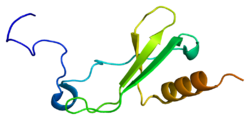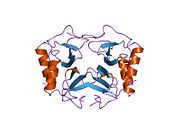CXCL7
| edit |
| Pro-trombocit bazični protein (hemokin (C-X-C motiv) ligand 7) | |||||||||||
|---|---|---|---|---|---|---|---|---|---|---|---|
 PDB prikaz baziran na 1f9p. | |||||||||||
| Dostupne strukture | |||||||||||
| 1f9p, 1nap, 1tvx | |||||||||||
| Identifikatori | |||||||||||
| Simboli | PPBP; PBP; B-TG1; Beta-TG; CTAP-III; CTAP3; CTAPIII; CXCL7; LA-PF4; LDGF; MDGF; NAP-2; SCYB7; TC1; TC2; TGB; TGB1; THBGB; THBGB1 | ||||||||||
| Vanjski ID | OMIM: 121010 MGI: 1888712 HomoloGene: 48122 GeneCards: PPBP Gene | ||||||||||
| |||||||||||
| Pregled RNK izražavanja | |||||||||||
 | |||||||||||
| podaci | |||||||||||
| Ortolozi | |||||||||||
| Vrsta | Čovek | Miš | |||||||||
| Entrez | 5473 | 57349 | |||||||||
| Ensembl | ENSG00000163736 | ENSMUSG00000029372 | |||||||||
| UniProt | P02775 | n/a | |||||||||
| RefSeq (mRNA) | NM_002704 | NM_023785 | |||||||||
| RefSeq (protein) | NP_002695 | NP_076274 | |||||||||
| Lokacija (UCSC) | Chr 4: 75.07 - 75.07 Mb | Chr 5: 91.84 - 91.85 Mb | |||||||||
| PubMed pretraga | [1] | [2] | |||||||||
CXCL7, hemokin (C-X-C motiv) ligand 7, je ljudski gen[1] koji kodira istoimeni protein. CXCL7 je mali citokin iz CXC hemokin familije. On je izoforma beta-tromboglobulina ili protrombocit bazični protein (PPBP).[2][3]
CXCL7 protein se oslobađa u velikim količinama iz trombocita nakon njihove aktivacije.[4] On stimuliše razne procese uključujući mitogenezu, sintezu ekstracelularnog matriksa, metabolizam glukoze i sintezu plazminogen aktivatora.[5][6]
Reference
- ↑ „Entrez Gene: PPBP pro-platelet basic protein (chemokine (C-X-C motif) ligand 7)”.
- ↑ Hristov M, Zernecke A, Bidzhekov K, et al. (March 2007). „Importance of CXC chemokine receptor 2 in the homing of human peripheral blood endothelial progenitor cells to sites of arterial injury”. Circ. Res. 100 (4): 590–7. DOI:10.1161/01.RES.0000259043.42571.68. PMID 17272812.
- ↑ Mire-Sluis, Anthony R.; Thorpe, Robin, ur. (1998). Cytokines (Handbook of Immunopharmacology). Boston: Academic Press. ISBN 0-12-498340-5.
- ↑ Majumdar S, Gonder D, Koutsis B, Poncz M (1991). „Characterization of the human beta-thromboglobulin gene. Comparison with the gene for platelet factor 4”. J Biol Chem 266 (9): 5785–9. PMID 1826003.
- ↑ Castor C, Miller J, Walz D (1983). „Structural and biological characteristics of connective tissue activating peptide (CTAP-III), a major human platelet-derived growth factor”. Proc Natl Acad Sci USA 80 (3): 765–9. DOI:10.1073/pnas.80.3.765. PMC 393460. PMID 6572368.
- ↑ Castor C, Furlong A, Carter-Su C (1985). „Connective tissue activation: stimulation of glucose transport by connective tissue activating peptide III”. Biochemistry 24 (7): 1762–7. DOI:10.1021/bi00328a029. PMID 4005226.
Literatura
- Begg GS, Pepper DS, Chesterman CN, Morgan FJ (1978). „Complete covalent structure of human beta-thromboglobulin.”. Biochemistry 17 (9): 1739–44. DOI:10.1021/bi00602a024. PMID 77677.
- Kaplan KL, Broekman MJ, Chernoff A, et al. (1979). „Platelet alpha-granule proteins: studies on release and subcellular localization.”. Blood 53 (4): 604–18. PMID 426909.
- Tunnacliffe A, Majumdar S, Yan B, Poncz M (1992). „Genes for beta-thromboglobulin and platelet factor 4 are closely linked and form part of a cluster of related genes on chromosome 4.”. Blood 79 (11): 2896–900. PMID 1316786.
- Cohen AB, Stevens MD, Miller EJ, et al. (1992). „Generation of the neutrophil-activating peptide-2 by cathepsin G and cathepsin G-treated human platelets.”. Am. J. Physiol. 263 (2 Pt 1): L249–56. PMID 1387511.
- Morris SW, Nelson N, Valentine MB, et al. (1992). „Assignment of the genes encoding human interleukin-8 receptor types 1 and 2 and an interleukin-8 receptor pseudogene to chromosome 2q35.”. Genomics 14 (3): 685–91. DOI:10.1016/S0888-7543(05)80169-7. PMID 1427896.
- Majumdar S, Gonder D, Koutsis B, Poncz M (1991). „Characterization of the human beta-thromboglobulin gene. Comparison with the gene for platelet factor 4.”. J. Biol. Chem. 266 (9): 5785–9. PMID 1826003.
- Wenger RH, Hameister H, Clemetson KJ (1991). „Human platelet basic protein/connective tissue activating peptide-III maps in a gene cluster on chromosome 4q12-q13 along with other genes of the beta-thromboglobulin superfamily.”. Hum. Genet. 87 (3): 367–8. DOI:10.1007/BF00200921. PMID 1830861.
- Hjemdahl P, Perneby C, Theodorsson E, et al. (1992). „A new assay for beta-thromboglobulin in urine.”. Thromb. Res. 64 (1): 33–43. DOI:10.1016/0049-3848(91)90203-9. PMID 1837963.
- Brandt E, Van Damme J, Flad HD (1991). „Neutrophils can generate their activator neutrophil-activating peptide 2 by proteolytic cleavage of platelet-derived connective tissue-activating peptide III.”. Cytokine 3 (4): 311–21. DOI:10.1016/1043-4666(91)90499-4. PMID 1873479.
- Clark-Lewis I, Moser B, Walz A, et al. (1991). „Chemical synthesis, purification, and characterization of two inflammatory proteins, neutrophil activating peptide 1 (interleukin-8) and neutrophil activating peptide.”. Biochemistry 30 (12): 3128–35. DOI:10.1021/bi00226a021. PMID 2007144.
- Walz A, Baggiolini M (1990). „Generation of the neutrophil-activating peptide NAP-2 from platelet basic protein or connective tissue-activating peptide III through monocyte proteases.”. J. Exp. Med. 171 (2): 449–54. DOI:10.1084/jem.171.2.449. PMC 2187709. PMID 2406364.
- Holt JC, Harris ME, Holt AM, et al. (1986). „Characterization of human platelet basic protein, a precursor form of low-affinity platelet factor 4 and beta-thromboglobulin.”. Biochemistry 25 (8): 1988–96. DOI:10.1021/bi00356a023. PMID 2423119.
- Walz A, Baggiolini M (1989). „A novel cleavage product of beta-thromboglobulin formed in cultures of stimulated mononuclear cells activates human neutrophils.”. Biochem. Biophys. Res. Commun. 159 (3): 969–75. DOI:10.1016/0006-291X(89)92203-1. PMID 2522778.
- Wenger RH, Wicki AN, Walz A, et al. (1989). „Cloning of cDNA coding for connective tissue activating peptide III from a human platelet-derived lambda gt11 expression library.”. Blood 73 (6): 1498–503. PMID 2713489.
- Castor CW, Walz DA, Ragsdale CG, et al. (1989). „Connective tissue activation. XXXIII. Biologically active cleavage products of CTAP-III from human platelets.”. Biochem. Biophys. Res. Commun. 163 (2): 1071–8. DOI:10.1016/0006-291X(89)92330-9. PMID 2783111.
- Holt JC, Rabellino EM, Gewirtz AM, et al. (1988). „Occurrence of platelet basic protein, a precursor of low affinity platelet factor 4 and beta-thromboglobulin, in human platelets and megakaryocytes.”. Exp. Hematol. 16 (4): 302–6. PMID 2966071.
- Castor CW, Furlong AM, Carter-Su C (1985). „Connective tissue activation: stimulation of glucose transport by connective tissue activating peptide III.”. Biochemistry 24 (7): 1762–7. DOI:10.1021/bi00328a029. PMID 4005226.
- McLaren KM, Pepper DS (1983). „Immunological localisation of beta-thromboglobulin and platelet factor 4 in human megakaryocytes and platelets.”. J. Clin. Pathol. 35 (11): 1227–31. DOI:10.1136/jcp.35.11.1227. PMC 497932. PMID 6183294.
- Castor CW, Miller JW, Walz DA (1983). „Structural and biological characteristics of connective tissue activating peptide (CTAP-III), a major human platelet-derived growth factor.”. Proc. Natl. Acad. Sci. U.S.A. 80 (3): 765–9. DOI:10.1073/pnas.80.3.765. PMC 393460. PMID 6572368.
- Malkowski MG, Wu JY, Lazar JB, et al. (1995). „The crystal structure of recombinant human neutrophil-activating peptide-2 (M6L) at 1.9-A resolution.”. J. Biol. Chem. 270 (13): 7077–87. DOI:10.1074/jbc.270.13.7077. PMID 7706245.
Spoljašnje veze
- MeSH Platelet+factor+7
- p
- r
- u
PDB Galerija
|








